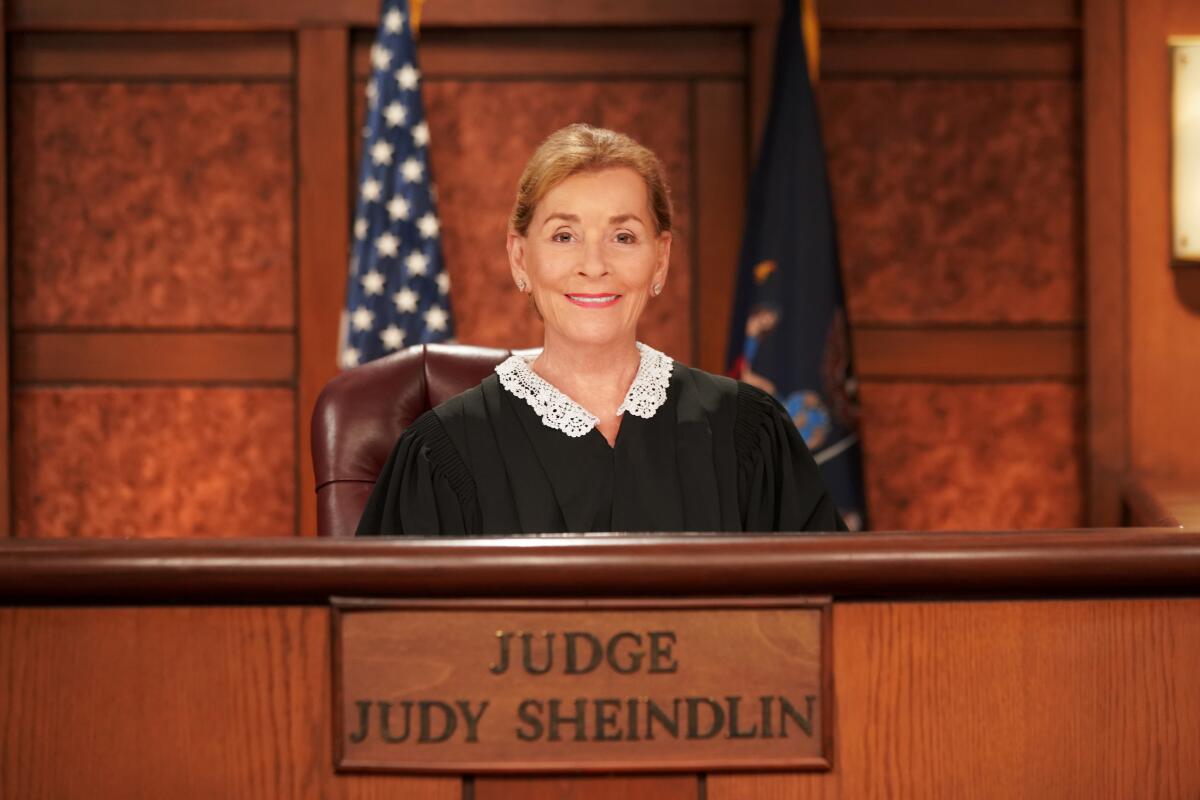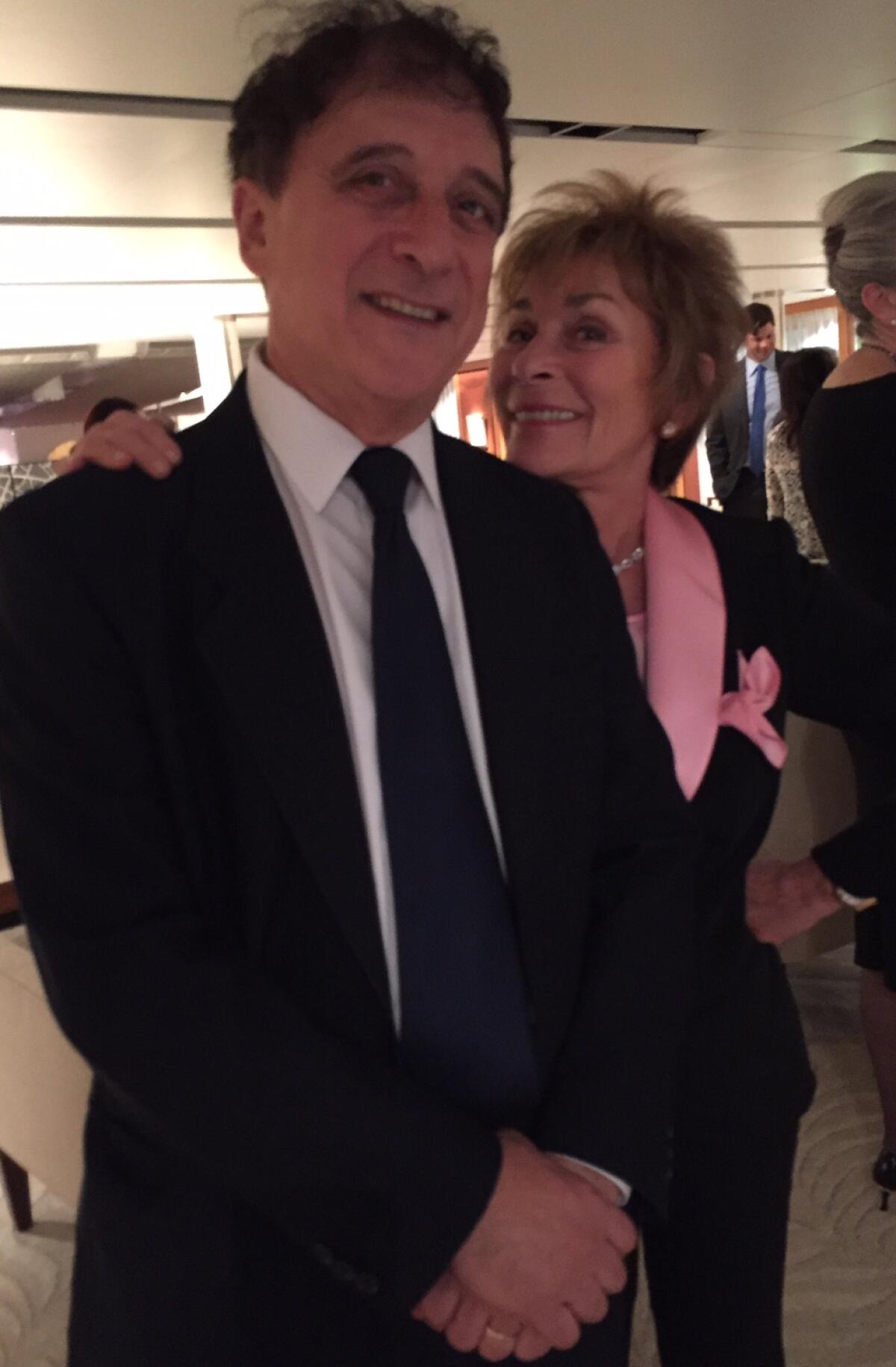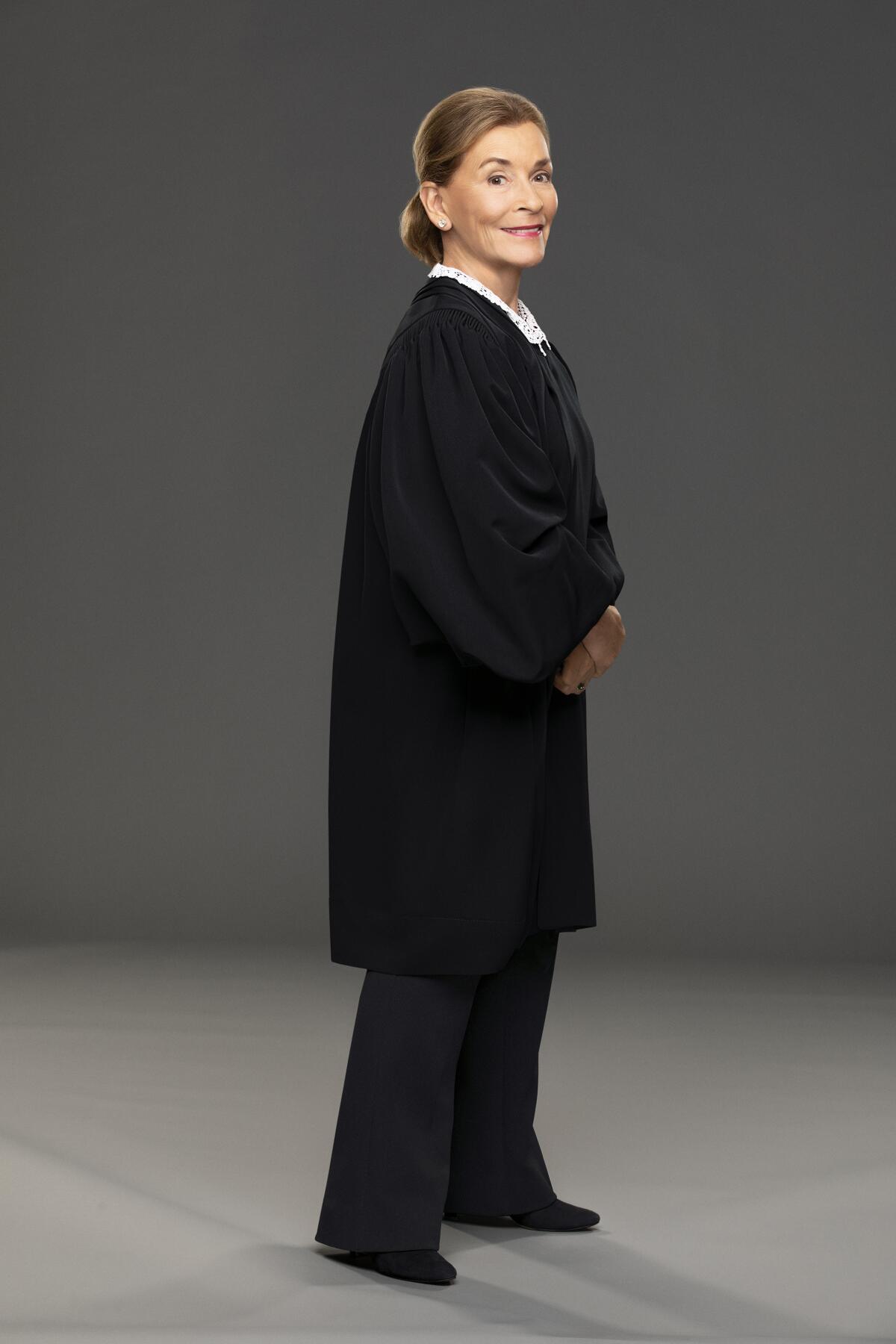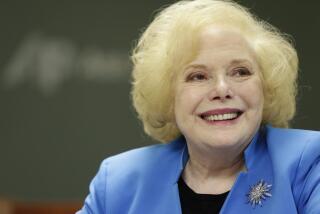The improbable true story of Judge Judy and the reporter who made her a star

For a courtroom TV show that has dominated daytime since 1998, the case decided April 15 on “Judge Judy” was hardly memorable: A building contractor who repaired a ceiling was suing the homeowner for an unpaid $500 bill. Judge Judith Sheindlin, who instantly smelled a rat, probed the defendant’s rambling excuses and delivered a swift verdict.
“Pay your bills,” she told the stunned homeowner. “Judgment for the plaintiff, and that’s all. We’re finished. Thank you very much!”
It’s a moment that would be familiar to anyone who’s watched the Emmy-winning phenomenon — which is to say, just about anyone — but as the courtroom cleared and the set went dark, history was made. The contractor’s case, running Tuesday, marks the last of more than 12,500 taped by Sheindlin during 25 years in the spotlight. “Judge Judy’s” final season on CBS ends Sept. 10.
As family members joined with her to celebrate, producers had a surprise: They played a video tribute with cameos by Jimmy Kimmel, Whoopi Goldberg, Ryan Seacrest, Kelly Ripa, Joy Behar, former New York City Mayor Michael Bloomberg, Meghan McCain and Wendy Williams. All showered praise on a woman who worked for more than two decades as a family court judge and prosecutor, reinvented herself at age 52 and went on to a brilliant second act. As staff members said their heartfelt goodbyes, the judge herself was uncharacteristically soft-spoken.
“I want to thank you from the bottom of my heart,” Sheindlin told them via video conference, set up as part of the show’s COVID-19 safety protocols. “I feel so blessed that you’ve given me the benefit of your talents over all these years — and changed the dynamic of me, my family and friends forever.”
An era had ended. But if you think Her Honor is slowing down, think again. The woman who cracks that her only hobby is work will unveil a new courtroom program, exclusively on Amazon’s free streaming service IMDb TV, later this year.
Looking back, she reflected on her improbable rise to the top.
“Let me start by thanking the two people who actually started my journey,” she told her staff. “Josh Getlin and Heidi Evans.”
In fall 1992, I was a national features writer for The Times, based in New York City. I’d begun a series about hardworking Americans who shook the bureaucratic cage with little or no success, but kept tilting at windmills. There would be four profiles, and the idea for the first one came from my wife, Heidi, a reporter for the New York Daily News.
She’d written a series about the state’s deteriorating juvenile justice system that summer, and she marveled at Sheindlin, a fiery, 5-foot 2-inch force of nature in Manhattan’s Family Court. Fed up with lazy colleagues and political correctness, the judge called the bureaucracy “a disaster” that didn’t protect the public against violent young criminals. “Shirley MacLaine will play her in a movie someday,” Heidi said.
Intrigued, I called Sheindlin to ask if I might write a profile about her. She agreed. It helped that she was the only Family Court judge who allowed the press into her courtroom. When I asked if there were any rules to follow, I got my first dose of what later would become familiar to millions: “No chewing gum,” she snapped. “And leave your gun at home.”
I watched Sheindlin in action for three weeks, handling 50 to 60 cases a day. She popped eight Tylenols each morning to prepare for an onslaught of juveniles who had been charged with violent crimes, custody disputes and child abuse cases. She smoked and worked out like a fiend to ward off the stress. There were no relaxing moments, not even during lunches we shared in her chambers.
One day, Sheindlin — who’d ordered her usual sushi — watched, appalled, as my giant burrito began spurting sour cream and guacamole after I bit into it. “And you wonder why you get heartburn,” she said. “Men!”
After finishing the article, I needed a vacation. But a larger story was just beginning — a Great Chain of Serendipity that would change her life and mine.

The profile ran on Valentine’s Day 1993, and I got an early morning call from the judge. She loved the piece, saying it was honest and fair. I learned later that she’d found a Manhattan newsstand that sold the Sunday Los Angeles Times and snapped up all the copies.
“In those days, this kind of expense ate into the budget,” she jokes during a recent interview from her home in Naples, Fla. “But it was worth it. You’re talking about someone who was, other than in my own little world, anonymous. Sometimes I felt in Family Court that, although I was respected, my views were as welcome as a skunk at a lawn party. So I enjoyed the moment.”
Several hours later, I got another call — from a “60 Minutes” associate producer. She’d read the profile and told me that Sheindlin was a natural candidate for a segment. Could I put her in touch with the judge? Judy (by now we were on a first-name basis) agreed to do the story, which aired in October 1993.
She watched nervously in her bedroom with her husband, Jerry Sheindlin, a New York Supreme Court judge, and was relieved that correspondent Morley Safer had treated her fairly. “That night, we went to a diner with my friend Elaine and her husband, Barry, to celebrate,” she recalls. “I had a tuna fish sandwich. Again, we thought that would be it.”
Several days later, Judy got a call from literary agent Jane Dystel, who saw the “60 Minutes” segment and told her she could write a compelling book. The judge said she wasn’t much of a writer, but agreed to try if she could write it with me.

We began collaborating on weekends, working at a small glass table in her tiny one-bedroom apartment on East 52nd Street in Manhattan. She had no food in her fridge, just Kodak film. Jerry ran out for bagels and coffee when I started to look faint. She talked, I typed.
My job was to shape her language, not her message. Every time I suggested that her view might be a bit harsh, she’d crack, “Josh, don’t be such a liberal.”
I thought the furious pace would ease when she announced one Sunday that she and Jerry were taking a Caribbean vacation. No such luck. While I had lunch at my desk the next day, the phone rang. It was Judy. “I got an idea for a new chapter walking on the beach,” she said. “Take this down.”
HarperCollins bought the book, but we needed a snappy title. Heidi said it could be a zinger the judge used in court, and Judy blurted out: “Don’t pee on my leg and tell me it’s raining.”
She loved the idea, but the publisher balked, saying TV shows would not interview her with such a title. Judy prevailed, and the book has sold 216,709 copies.
But the biggest surprise was still around the corner.

In 1993, Judge Joseph Wapner ended his 12-year run on the syndicated courtroom show “The People’s Court.” Two of its producers told Judy, who was looking to leave Family Court, that she could star in her own show. Larry Lyttle, head of Big Ticket Television, shot a marketing reel and the rest is history: Three years later, “Judge Judy” was the highest-rated show in daytime TV.
The Times profile had launched a legend, as Judy became one of TV’s most well-paid stars, earning $47 million annually. Today, she owns beautiful homes in several states and no longer inhales Tylenols to start her day. Otherwise, she’s remarkably unchanged. While celebrity warps many stars, Judy insists she’s the same person who survived Manhattan’s Family Court.
“I’ve always been me,” she says. “I came to Hollywood as a fully-cooked gal.”
Television executives learned this the hard way, when Judy put on a master class in how to get paid what she was worth, given the show’s astronomical profits — without even the semblance of negotiations.
She’s also one of the most fun-loving people I know. Judy threw a bash for family and friends one night in 2015 aboard the World cruise ship, docked in Manhattan. The highlight came when she sat at a piano, vodka and diet cranberry cocktail in hand, to belt out a duet with Neil Sedaka on “Breaking Up Is Hard to Do.”
As a journalist, I’ve interviewed thousands of people , but only a handful have turned into sustained friendships like the one my wife and I have with Judy. Over 29 years, she’s become more family than friend.
When our daughter, Alex, turned 1, Judy and Jerry came to her birthday party in judicial robes. With great ceremony, they “swore her in” as a citizen of New York City. When Heidi expressed a vague yearning to have a second child, Judy ruled her out of order, saying that one kid was a full-time job and that she already had a second full-time job at the Daily News. “Take a deep breath and count to 10,” she advised. “The feeling will pass. Get a dog.”
Over the years, we gathered at her home in Greenwich, Conn., for Thanksgiving. One night, Judy took Alex, then 8, by the hand to meet Michael Feinstein, a Grammy-nominated performer and music historian, who was a friend. “This is Alex,” she said with a wink, as the two shook hands. “She also sings and plays the piano.”
‘Byrd’ and ‘Judge Judy’: It’s a bond that’s secure
Judy had set up a karaoke machine for guests and grandkids who wanted to perform, and Alex began singing Broadway tunes in the judge’s living room, every year for nine years. Feinstein became Alex’s mentor, and at 17, she performed a solo cabaret show at his Park Avenue club. The judge was there that night, cheering her on.
“The world is big, but the circle is small,” Judy says of our history. “Every once in a while you meet someone who falls into your life and changes your life.”
As “Judge Judy” ends, pundits will speculate on Sheindlin’s legacy. The show is comfort food for those who love it when the bad guys get their comeuppances. Her focus on personal responsibility also resonates.
At the same time, the national conversation around criminal justice, especially juvenile justice, has changed since her battles as a hard-liner in Family Court. “The country is reflecting on historic and current inequities with a goal of meaningful change,” she says. “But to me, there are constants: Take care of the children that you bring into this world. Don’t steal other people’s property. Respect the community where you live.”
Asked about her show’s impact, Judy adds: “So many of the emails and letters I get are from women who watched me and had their daughters watch me. They told me the show helped them take the next step, whether it was getting a divorce, leaving an abusive person, asking for a raise and never, ever becoming somebody’s prisoner.”
Judy knows from next steps. She has no plans to retire, no desire to dial it down. At age 78, she’s moving full speed ahead on a new show. And that, for me, is her true legacy — that there are second, third and maybe even fourth acts in American life.
As she said at her last taping: “That’s all. We’re finished. Thank you very much!”
Next!
‘Judge Judy’
’
Where: CBS
When: 4 p.m. Weekdays
Rating: TV-PG (may be unsuitable for young children)
More to Read
The complete guide to home viewing
Get Screen Gab for everything about the TV shows and streaming movies everyone’s talking about.
You may occasionally receive promotional content from the Los Angeles Times.






